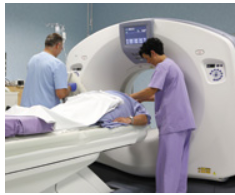
44-Year-Old Male with Skull Fracture
William Hancock, 44, fell from the scaffolding at a construction site. When emergency personnel arrived, they found him unconscious but with stable vital signs. As paramedics placed him on a backboard to stabilize his head, neck, and back, they noted watery blood leaking from his right ear. In the hospital, Mr. Hancock regained consciousness and was treated for deep lacerations on his scalp and face. Head CT scans revealed both longitudinal and transverse fractures of the right petrous temporal and sphenoid bones that extended through the foramen rotundum and foramen ovale.

The following observations were recorded on Mr. Hancock’s chart on admission:
•Complete loss of hearing in the right ear.
•Paresthesia (sensation of “pins and needles’) at the right corner of the mouth, extending to the lower lip and chin.
•Numbness of the right upper lip, lower eyelid, and cheek.
•Right eye turned slightly inward when looking straight ahead. Diplopia (double vision), particularly when looking to the right.
1. NCLEX-STYLE Which of the following choices best describes the fluid leaking from Mr. Hancock's ear and the cause of that leakage?
a. Blood and mucus are leaking because the sphenoid bone is fractured.
b. Blood and mucus are leaking because the petrous part of the temporal bone is fractured.
c. Blood and cerebrospinal fluid are leaking because the petrous part of the temporal bone is fractured.
d. Blood and sweat are leaking because the sphenoid bone is fractured and because his temperature was elevated.
Want to see the full answer?
Check out a sample textbook solution
Chapter 13 Solutions
HUMAN ANAT.+PHYSIOLOGY (LL)-PKG.
- Lin, a 5-year-11-month-boy was admitted to a paediatric hospital. No neck stiffness, Kernig's sign (-), Brudzinski's sign (-), Babinski's sign (-). All joints had no swollen and tenderness. The outpatient physician then ordered blood routine and peripheral blood smear tests. To find out the reasons for the elbows pain, bilateral tibia, ulnar, femur and fibula films were taken. Blood routine test: WBC=7.2 x 109/L, RBC=3.1 x 109/L, BPC=64 x 109/L, Hb=90g/L, atypical cells 7%. Peripheral blood smear test: blast=18%, L=48%, N=31%. Bilateral tibia, ulnar, femur and fibula films: no obvious bone tissue damage in the bilateral ulnar, fibula, lower section of the tibia and the distal part of the femur. The outpatient physician suggested the parents to sign the consent form of bone marrow aspiration immediately and wished to proceed with the procedure as soon as possible to analyse the immune markers. The physician also informed the parents that, if necessary, Lin may need to have a bone marrow…arrow_forwardWhat serious consequence could result from a rupture of the transverse ligament?arrow_forwardA high-school football player died 2 days after a serious head wound received on the field during the game. He butted heads with another player hard enough to cause his skull to fracture. For a few moments, his injury did not seem serious; however, the referee ordered him off the field where he collapsed. Paramedics were called, and he was rushed to the emergency room. 1.How could such an injury be prevented? 2.As a parent or a coach, what precautions would you want to take during practices and games? 3.Identify the appropriate steps taken in this situation. ****PLEASE INCLUDE CITATIONS MLA 9TH EDITION PERDUE OWL****arrow_forward
- A. B- LE identify the following labeled structures:arrow_forwardMedical terminology for advanced dysplasia?arrow_forwardAfter falling off a horse, Mary complained of pain on the right side of her thorax that intensified when she took a deep breath or coughed. The emergency medical technician suspected a broken rib. Using palpation, how could the EMT identify the precise location of the injury?arrow_forward
 Fundamentals of Sectional Anatomy: An Imaging App...BiologyISBN:9781133960867Author:Denise L. LazoPublisher:Cengage LearningUnderstanding Health Insurance: A Guide to Billin...Health & NutritionISBN:9781337679480Author:GREENPublisher:CengageSurgical Tech For Surgical Tech Pos CareHealth & NutritionISBN:9781337648868Author:AssociationPublisher:Cengage
Fundamentals of Sectional Anatomy: An Imaging App...BiologyISBN:9781133960867Author:Denise L. LazoPublisher:Cengage LearningUnderstanding Health Insurance: A Guide to Billin...Health & NutritionISBN:9781337679480Author:GREENPublisher:CengageSurgical Tech For Surgical Tech Pos CareHealth & NutritionISBN:9781337648868Author:AssociationPublisher:Cengage Medical Terminology for Health Professions, Spira...Health & NutritionISBN:9781305634350Author:Ann Ehrlich, Carol L. Schroeder, Laura Ehrlich, Katrina A. SchroederPublisher:Cengage Learning
Medical Terminology for Health Professions, Spira...Health & NutritionISBN:9781305634350Author:Ann Ehrlich, Carol L. Schroeder, Laura Ehrlich, Katrina A. SchroederPublisher:Cengage Learning



